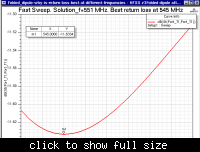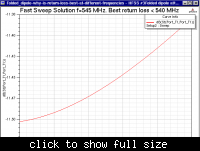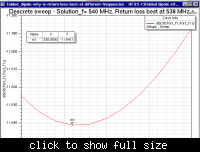DeboraHarry
Full Member level 5
I'm trying to simulate a folded dipole in HFSS. I'm finding that as I change the solution frequency, the results appear to change quite dramatically. See the attached file. This has 3 designs in it - ignore #1 and #2, and just look at #3. I'm interested in finding the frequency at which the return loss is minimum.
I estimated this would be at 551 MHz, based on some other software, so I
1) Did a fast-sweep in HFSS 14 and found the return loss to be maximum at 545 MHz. (Setup 1 in the attached file)

2) Then I decided to try to get a more accurate figure, by using smaller steps. I then set the solution frequency to be 545 MHz (Setup #2). I did this over the range 540-550 MHz, since I thought the best return loss was around 545 MHz. However, the graph shows the best return loss as being under 540 MHz, yet the first sweep had shown it to be 545 MHz. That's a difference of at least 5 MHz.

3) Sweep #4 shows a discrete sweep.

This indicates the best return loss is at 538 MHz, so is 8 MHz away from the first figure I got.
Is this sort of thing to be expected? Is the fact the first figure differs so much from the others due to the fact the solution frequency was not as accurate?
It's hard to know when to trust the results in this case. I' expect the discrete sweep might be the more accurate result, but are still not sure whether to trust it.
Deborah
I estimated this would be at 551 MHz, based on some other software, so I
1) Did a fast-sweep in HFSS 14 and found the return loss to be maximum at 545 MHz. (Setup 1 in the attached file)

2) Then I decided to try to get a more accurate figure, by using smaller steps. I then set the solution frequency to be 545 MHz (Setup #2). I did this over the range 540-550 MHz, since I thought the best return loss was around 545 MHz. However, the graph shows the best return loss as being under 540 MHz, yet the first sweep had shown it to be 545 MHz. That's a difference of at least 5 MHz.

3) Sweep #4 shows a discrete sweep.

This indicates the best return loss is at 538 MHz, so is 8 MHz away from the first figure I got.
Is this sort of thing to be expected? Is the fact the first figure differs so much from the others due to the fact the solution frequency was not as accurate?
It's hard to know when to trust the results in this case. I' expect the discrete sweep might be the more accurate result, but are still not sure whether to trust it.
Deborah